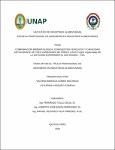| dc.contributor.advisor | Tello Célis, Fernando | |
| dc.contributor.advisor | Bazán Ferrando, Alberto José | |
| dc.contributor.advisor | Vela Paredes, Rafael Segundo | |
| dc.contributor.author | Gómez Reátegui, Valeria Marcela | |
| dc.contributor.author | Vasquez Icomena, Liz Karina | |
| dc.date.accessioned | 2025-06-27T17:01:25Z | |
| dc.date.available | 2025-06-27T17:01:25Z | |
| dc.date.issued | 2024 | |
| dc.identifier.other | 664.805652 G68 2024 | |
| dc.identifier.uri | https://hdl.handle.net/20.500.12737/11521 | |
| dc.description.abstract | The objective of this research was to evaluate the differences in nutritional and functional characteristics of three varieties of cowpea: black, brown, and white. Although cowpea is an important crop in Peru, its per capita consumption is relatively low compared to other countries. The study included a proximate analysis that revealed that all varieties are rich in protein (22.45% to 23.72%) and fiber (4.15% to 4.82%), with an energy content of approximately 345 to 349 kcal per 100 g. The color characteristics of the beans were evaluated using a colorimeter, showing that the black variety had a lower luminosity and higher values in the a* and b* coordinates, indicating a darker color. Total phenolic compounds were quantified using the Folin-Ciocalteu method, finding that the black variety had the highest content (38.15 ± 2.49 mg EAG/100 g DM). Antioxidant capacity was measured by DPPH and ABTS assays, where the black variety also showed the highest antioxidant activity. Principal Component Analysis (PCA) confirmed that differences in phenolic compound content and antioxidant capacity are significant among varieties. The research concludes that cowpeas, especially black-colored, represent a valuable source of nutrients and bioactive compounds, underlining the need to promote their consumption to improve public health and nutrition in Peru. | en_US |
| dc.description.abstract | El objetivo de esta investigación fue evaluar las diferencias en las características nutricionales y funcionales de tres variedades de frejol caupí: negro, marrón y blanco. A pesar de que el frejol caupí es un cultivo importante en Perú, su consumo per cápita es relativamente bajo en comparación con otros países de la región. El estudio incluyó un análisis proximal que reveló que todas las variedades son ricas en proteínas (22.45% a 23.72%) y fibra (4.15% a 4.82%), con un contenido energético de aproximadamente 345 a 349 kcal por cada 100 g. Las características de color de los granos fueron evaluadas mediante un colorímetro, mostrando que la variedad negra tenía una menor luminosidad y mayores valores en las coordenadas a* y b*, indicando un color más oscuro. Los compuestos fenólicos totales se cuantificaron utilizando el método de Folin-Ciocalteu, encontrando que la variedad negra tenía el contenido más alto (38.15 ± 2.49 mg EAG/100g MS). La capacidad antioxidante se midió mediante los ensayos DPPH y ABTS, donde la variedad negra también mostró la mayor actividad antioxidante. El análisis de componentes principales (ACP) confirmó que las diferencias en el contenido de compuestos fenólicos y la capacidad antioxidante son significativas entre las variedades. La investigación concluye que el frejol caupí, especialmente de coloración negra, representa una fuente valiosa de nutrientes y compuestos bioactivos, subrayando la necesidad de promover su consumo para mejorar la salud pública y la nutrición en Perú. | es_PE |
| dc.format | application/pdf | es_PE |
| dc.language.iso | spa | es_PE |
| dc.publisher | Universidad Nacional de la Amazonía Peruana | es_PE |
| dc.rights | info:eu-repo/semantics/openAccess | * |
| dc.rights.uri | https://creativecommons.org/licenses/by/4.0/ | * |
| dc.subject | Tecnología de alimentos | es_PE |
| dc.subject | Frejol caupí | es_PE |
| dc.subject | Vigna unguiculata | es_PE |
| dc.subject | Variedades | es_PE |
| dc.subject | Compuestos fenólicos | es_PE |
| dc.subject | Propiedades antioxidantes | es_PE |
| dc.title | Comparación bromatológica, compuestos fenólicos y capacidad antioxidante de tres variedades de frejol caupí (Vigna unguiculata) de la estación experimental San Ramón – INIA | es_PE |
| dc.type | info:eu-repo/semantics/bachelorThesis | es_PE |
| thesis.degree.discipline | Ingeniería en Industrias Alimentarias | es_PE |
| thesis.degree.grantor | Universidad Nacional de la Amazonía Peruana. Facultad de Industrias Alimentarias | es_PE |
| thesis.degree.name | Ingeniero(a) en Industrias Alimentarias | es_PE |
| dc.subject.ocde | https://purl.org/pe-repo/ocde/ford#2.11.01 | es_PE |
| renati.author.dni | 71247262 | |
| renati.author.dni | 47070731 | |
| renati.advisor.orcid | https://orcid.org/0000-0002-1800-5366 | |
| renati.advisor.orcid | https://orcid.org/0000-0002-6467-0981 | |
| renati.advisor.orcid | https://orcid.org/0000-0001-7255-6209 | |
| renati.advisor.dni | 05374789 | |
| renati.advisor.dni | 05323630 | |
| renati.advisor.dni | 46516515 | |
| renati.type | https://purl.org/pe-repo/renati/type#tesis | es_PE |
| renati.discipline | 721046 | es_PE |
| renati.level | https://purl.org/pe-repo/renati/level#tituloProfesional | es_PE |
| renati.juror | Gonzales Rios, Littman | |
| renati.juror | Vasquez Angulo, Julia Desire | |
| renati.juror | Vegas Perez, Carlos Alfredo | |
| dc.publisher.country | PE | es_PE |





